Abstract
In the present study, the microstructure and mechanical properties of a new Mg-4Al-3.5Ca-2Gd (AXE432) alloy are investigated. The microstructure of the as-cast AXE432 alloy consists of α-Mg, C14 (Mg2Ca), and C36((Mg, Al)2Ca) phases. After the heat treatment at 480 °C for 8 h, the C14 with fine lamellar structure changes from narrow stripes to micro-scale particles, and part of the C36 and the C14 dissolve into the α-Mg matrix, with many short needle-shaped C15 (Al2Ca) phase precipitating in the primary a-Mg grains. The AXE432 alloy extruded at a temperature as high as 420 °C exhibits a refined dynamically recrystallized (DRXed) microstructure with grain sizes less than 1.5 ± 0.5 μm and a strong {0001}<100> basal texture with a maximum intensity of 5.62. A complex combination of the effects from grain size, texture, second-phase particles, and strain hardening results in balanced mechanical properties, with the tensile yield strength (TYS), ultimate tensile strength (UTS), elongation (El), compressive yield strength (CYS), and ultimate compressive strength (UCS) of 331.4 ± 2.1 MPa, 336.9 ± 3.8 MPa, 16.1 ± 2.3%, 270.4 ± 1.6 MPa and 574.5 ± 12.4 MPa, respectively.
1. Introduction
Driven by the demand for energy-saving and emission reduction in the transport industry, both at home and abroad, there have been strong and increasing demands for developing high-strength and tough wrought Mg alloys in recent years [1,2,3]. The Mg-Al-Ca-Mn alloy [4,5,6,7,8] is a new high-strength rare earth (RE)-free wrought Mg alloy developed in recent years. Xu et al. [4] prepared an extruded Mg-3.5Al-3.3Ca-0.4Mn (wt.%, thereafter) alloy at 350 °C and reported that the fine intermetallic particles is effective in suppressing the grain growth during the hot extrusion process, which resulted in the formation of ultrafine dynamically recrystallized (DRXed) grains of 1.2 μm. This alloy exhibited ultra-high TYS of 410 MPa and UTS of 420 MPa, but a low El of 5.6%. The Mg-Al-Ca alloys contain thermally stable intermetallic compounds Mg2Ca (C14), Al2Ca (C15), and (Mg, Al)2Ca (C36), which are related to the alloy composition, especially the content and ratio of Al and Ca [5]. Li et al. [5] reported that the Ca/Al ratio significantly influences the microstructure and mechanical properties of the as-cast and as-extruded Mg-Al-Ca-Mn alloys. With the Ca/Al ratio increased from 0.25 to 0.90, the main second phase changes from C36 with a devoiced eutectic structure to C14 with a fine lamellar morphology in the as-cast microstructures. The extruded Mg-3Al-2.7Ca-0.4Mn (AXM3304) alloy with a Ca/Al ratio of 0.9 exhibited an extremely high UTS of 439 MPa and a low El of 3.9%. However, with the Ca/Al ratio increased to 1.3, the UTS of the extruded Mg-2.7Al-3.5Ca-0.4Mn alloy increased to 457 MPa, while the El% decreased to only 2.5%, showing an obvious brittle characteristic. It was found that both the small grain size and the dispersive second-phase particles can contribute to the high strength of this Mg-Al-Ca-Mn alloy. However, the application of Mg alloys in the transport industry is severely challenging for light-weighting and safety performance. Strength, plasticity, and corrosion resistance are all crucial factors to be considered. Therefore, the low ductility of the Mg-Al-Ca-Mn alloys will restrict their applications in the industry.
Large numbers of literatures [9,10,11,12,13,14,15] have reported that alloying with rare earth (RE) elements can significantly improve the comprehensive performance of Mg alloys and has thus become the key alloying elements for the Mg industry to strengthen competitiveness. For example, some Gd-containing wrought alloys, including Mg-Gd-Zr [12], Mg-Gd-Y-Zr [13], Mg-Gd-Y-Zn-Zr [14,15], all exhibited UTS higher than 400 MPa and YTS higher than 350 MPa. However, the RE contents of these alloys often exceeded 10%, resulting in high costs and limited applications. Moreover, because of the large number and large size of the second phases, these high RE-containing Mg alloys showed poor elongations lower than 10%. Wu et al. [16] have proved that RE, Zr, Ca, and Mn solutes can induce ductility at extremely low concentrations (c ~0.03 to 0.3 at%) in magnesium alloy by using density functional theory (DFT)–computed inputs. The reason is that specific dilute solute additions can increase the <c + a> cross-slip and multiplication rates to levels much faster than the deleterious <c + a> transformation, enabling both favorable texture during processing and continued plastic straining during deformation.
Therefore, in the present study, 2 wt.% (0.3 at.%) of the RE element Gd was chosen to be added to a Mg-4Al-3.5Ca alloy with a Ca/Al ratio of 0.875 to improve the ductility. The morphology of the as-cast and extruded Mg-4Al-3.5Ca-2Gd (AXE432) is studied, and the effects of second-phase particles on the DRXed microstructure during hot extrusion are examined to clarify the mechanism of dynamic recrystallization. Furthermore, the reason why the novel AXE432 wrought alloy exhibited balanced mechanical properties is explored.
2. Materials and Methods
The Mg-4Al-3Ca-2Gd (wt.%) (Mg-3.7Al-2.2Ca-0.3Gd, at.%) alloy ingot was produced in an electric resistance furnace under a protective atmosphere (0.5 vol.% SF6 + 99.5 vol.% CO2). The raw materials included pure Mg (99.9 wt.%), pure Al (99.9 wt.%), Mg-25 wt.% Ca and Mg-30 wt.% Gd master alloys. The master alloys were provided by Yueyang Yuhua Metallurgical New Materials Co., Ltd. (Yueyang, China). Prior to extrusion, the as-cast billet (Ø125 mm × 200 mm) was homogenized at 480 °C for 8 h, followed by hot water quenching. After homogenization, the billet was machined to the size of Ø120 mm × 180 mm to remove the oxide scale. The extrusion was conducted at 420 °C with an extrusion ratio of 60 at a ram speed of 0.2 mm/s.
For microstructural examination, specimens were polished by using standard metallographic techniques and then given an additional etching step for ∼8 s in acetic picral (10 mL water + 4.2 g picric acid + 10 mL acetic acid + 70 mL ethanol) to display grain structure, dendrite structure, and second phases. Microstructures of the specimens were investigated by optical microscopy (OM, Zeiss axio observer Alm, Oberhausen, Germany), scanning electron microscope (SEM, Zeiss EVO MA10, Oberhausen, Germany), and energy-dispersive spectrometer (EDS, Bruker Xflash, Karlsruhe, Germany). The extrusion textures and deformed microstructures were measured by electron backscatter diffraction (EBSD) (Bruker e-Flashfs, Karlsruhe, Germany). The samples for EBSD test were grounded by using standard metallographic techniques and then given Ar ion beam-polishing by SEM Prep 2 (Linda, http://www.technoorg.hu, accessed on 1 April 2023). The EBSD data were analyzed via HKL-Channel 5 software.
The samples for mechanical property testing were machined out from the extruded bars along the extrusion direction (ED) and were tested on an MTS Landmark 370.25 (50 kN, MN, USA) at a crosshead speed of 2 mm/min. The tensile tests were conducted with the dog-bone specimens in the gage length of 25 mm and a diameter of 5 mm, and the cylindrical samples for compression tests were Φ10 mm × 15 mm. The tests were performed three times for each condition, and then the results were averaged to improve reliability.
3. Results and Discussion
3.1. Microstructure of the As-Cast AXE432 Alloy
Figure 1 shows the microstructure of the as-cast AXE432 alloy. It can be seen from Figure 1a,b that the sample has an equiaxed dendritic microstructure with an interdendritic eutectic structure. Most second phases appear in a netlike distribution along the Mg boundaries. However, there are many small particles distributed uniformly in the matrix. As seen in the SEM images of Figure 1c,d, the second phases show a mixture of divorced eutectic and coarse lamellar eutectic structures. The EDS analysis results of these second phases are shown in Table 1. The white block phases distributed in the α-Mg grains have an Al2Gd composition, and the lamellar eutectic compounds formed along the grain boundaries and between dendrites are enriched with Mg, Al, and Ca.
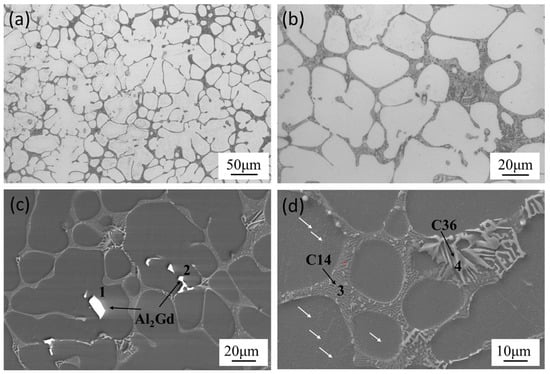
Figure 1.
Microstructures of the as-cast AXE432 alloy. (a,b) Optical and (c,d) SEM images. The EDS results of the second phases pointed by arrows and marked by 1–4 are in Table 1.

Table 1.
EDS results of the second phases 1 to 4 in Figure 1.
As solidification takes place, the alloy elements are pushed to the advancing solid/liquid interface. Subsequently, interdendritic second phases precipitate along the grain boundaries once the eutectic solidification condition is met. It has been believed that there are two main Ca-containing phases in Mg-Al-Ca alloys: C14 and C15 [17]. Luo et al. [18] found the existence of the C36 phase with a hexagonal crystal structure in the AMC503 alloy. Suzuki et al. [19,20] further identified this phase as a new Laves phase with a C36 structure. Many studies [5,21,22] have shown that the formation of Ca-containing phases is controlled by the Ca/Al mass ratio in the Mg-Al-Ca system alloys. Li et al. [5] also found that the main second phases of the as-cast AXM3304 alloy with a Ca/Al ratio of 0.90 are C14 with a fine lamellar structure and C36 with a divorced eutectic structure. Liang et al. [21] found that C15 and Mg17Al12 coexist in the as-cast microstructure of the AZC912 alloy with a Ca/Al ratio of 0.23. As the Ca/Al ratio increases to 0.32 (AMC502), most of the second phases are C36, while in AMC503 with a Ca/Al ratio of 0.54, both the C36 and C14 appear. With the Ca/Al mass ratios increased to 0.90, the C14 with a fine lamellar structure became the main second phase. For the present AXE432 alloy with a Ca/Al ratio of 0.875, based on the EDS analyses and the morphological characteristics of the as-cast microstructure, the fine lamellar eutectic compounds were identified as C14, and the coarse eutectic compounds were identified as C36, as shown in Figure 1d and Table 1.
Moreover, many short needle-shaped precipitates can be observed in the primary a-Mg grains, as pointed out by the white arrow in Figure 1d. Liang et al. [21] and Rzychoń [23] also found this second phase with the same morphology in the as-cast Mg-5Al-3Ca-0.3Mn and Mg-5Al-3Ca-0.7Sr-0.2Mn alloys, respectively. Rzychoń [23] identified it as the C15 phase by nano-beam electron diffraction.
Before extrusion, homogenization treatment is often used to obtain a more uniform microstructure, and the selected temperature should be lower than the temperature at which the liquid phase exists. According to the calculated projection of the Mg-Al-Ca liquidus surface by Janz et al. [24], the eutectic point of the Mg-rich corner is 515 °C, at which a Mg-4Al-3.5Ca alloy could experience the eutectic reaction (L ⇋ (Mg) + C14 + C36) during the heat treatment process. For this reason, 480 °C was chosen as the homogenization temperature. Figure 2 shows the microstructures of the AXE432 alloy with the heat treatment of 480 °C for 8 h. Most of the second phases did not dissolve in the α-Mg matrix; however, the C14 with fine lamellar structure changes from narrow stripes to micro-scale particles. Additionally, more and bigger needle-shaped precipitates appear within the a-Mg grains. The EDS results of the second phases pointed by arrows and marked by 1–5 in Figure 2c,d are in Table 2. The EDS result of the needle-shaped precipitate shows higher Al contents than the matrix. Suzuki et al. [20] found that the C36 phase in Mg-5Al-3Ca based alloys transformed to the C15 phase by a shear-assisted mechanism after 1000 h aging, and many needle-shaped C15 phase precipitated within the a-Mg grains. Therefore, it is possible that part of the C36 and the C14 dissolved in the α-Mg matrix and precipitated as C15 with better thermal stability during the heat treatment at 480 °C.
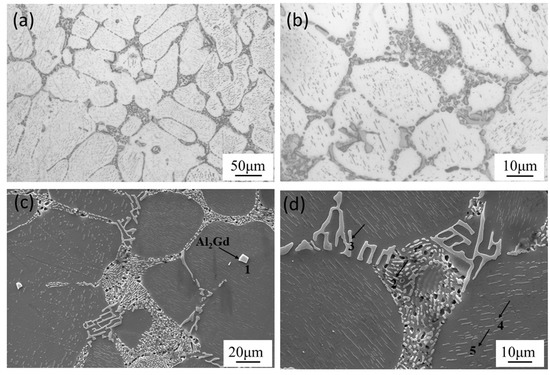
Figure 2.
Microstructures of the heat-treated AXE432 alloy. (a,b) Optical and (c,d) SEM images. The EDS results of the second phases pointed by arrows and marked by 1–5 are in Table 2.

Table 2.
EDS results of the second phases 1 to 5 in Figure 2.
3.2. Microstructure of the As-Extruded AXE432 Alloy
After heat treatment at a temperature as high as 480 °C for 8 h, the AXE432 alloy still contains large amounts of thermally stable particles. As it is known, particles with certain sizes can play a particle-stimulated nucleation (PSN) effect or grain boundary pinning effect during the hot deformation process of Mg alloys [25,26]. As shown in Figure 3a, the as-extruded AXE432 alloy exhibits a refined DRXed microstructure, and the lamellar structure is fragmented into dense fine particles smaller than 5 μm, forming strips along the extrusion direction (ED).
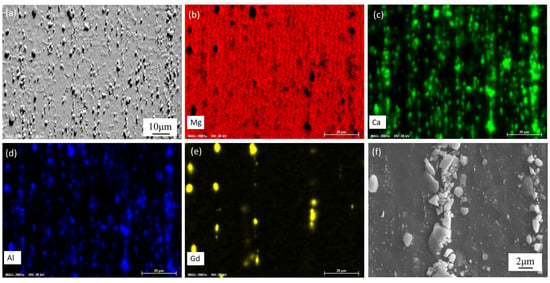
Figure 3.
Microstructure and the EDS map scanning result of the as-extruded AXE432 alloy. (a) SE image. The distribution of Mg (b), Al (c), Ca (d) and Gd (e) elements. (f) The morphology of the second-phase particles at a higher magnification.
Figure 3b–e shows the distribution of Mg, Ca, Al, and Gd elements. The distributions of Gd and Al are overlapped, as well as the Al, Mg and Ca, confirming the existence of the Al-Gd and Mg-Al-Ca compounds. Considering the microstructure of the heat-treated AXE432 alloy, the second phases in the as-extruded AXE432 alloy should include Al2Gd, C14, C15, and C36. As shown in Figure 3f, many particles with a size smaller than 1 μm were observed within the α-Mg grains. It was found that the presence of the particles smaller than 1 μm could restrict the growth of the α-Mg grains by pining the grain boundaries or dislocations [26]. Particle-stimulated nucleation (PSN) of recrystallized grains is usually observed around particles with diameters greater than approximately 1 µm. High dislocation density and large orientation gradient in the deformation zone around the particles are necessary criterions for the formation of the nucleus of recrystallized grains.
Figure 4 shows the EBSD results of the area shown in Figure 3a. The average grain size is 1.5 ± 0.5 μm, which is determined by the grain size statistics function of HKL-Channel 5. Many reported wrought Mg alloys [4,5,27,28,29,30] with fine grain size smaller than 5 μm were extruded below 350 °C, especially below 300 °C, which belong to the medium-low temperature deformation. As it is known, the deformation capacity of Mg alloys is limited at a lower temperature due to the lack of slip system, resulting in higher deformation resistance and increasing difficulty in producing extruded profile with complex cross-sections. However, the DRXed grain sizes of Mg alloys increase with the deformation temperature, which will deteriorate their strengths. Generally, Mg alloys extrud at temperatures higher than 400 °C exhibit coarse microstructures with grain sizes larger than 5 μm and poor strengths [2]. For example, the AZ31 alloy extruded under an extrusion ratio of 20 and a die-exit speed of 1.2 m/min at 350 °C exhibited a fully DRXed microstructure with an average grain size of 16.2 μm and a low TYS of 154 MPa [31]. In another study [32], as the extrusion temperature increased from 210 °C to 400 °C, the grain size of the dilute Mg-1.0Zn-0.5Ca alloy increased from 0.5–0.6 μm to 20–30 μm, and the TYS decreased form 297 ± 2 MPa to 99 ± 2MPa. For a Mg-14.3Zn-3.2Y alloy with a higher alloy concentration, as the extrusion temperature increased from 250 °C to 390 °C, the grain size increased from 0.98 ± 0.16 μm to 5.14 ± 0.87 μm, and the YTS decreased form 386.3 ± 2.8 MPa to 268.3 ± 2 MPa [33]. In contrast, the present AXE432 alloy maintains a DRXed grain size of only 1.5 ± 0.5 μm even at the deformation temperature as high as 420 °C, which means that the uniform distribution of thermal stable particles was effective in decreasing the DRXed grain size during the hot deformation of Mg alloys.
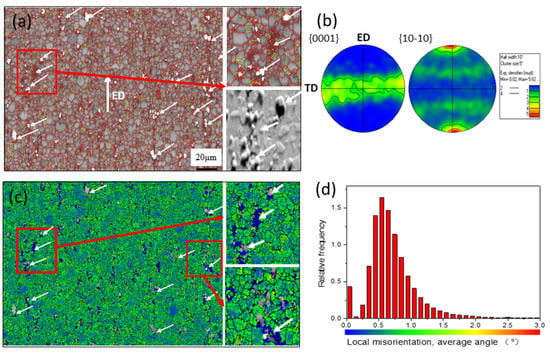
Figure 4.
The EBSD result of the as-extruded AXE432 alloy corresponding to Figure 3a. (a) The Image Quality (IQ) map with grain boundaries. (Insets: the magnified image of the area marked by red box in a) (b) The pole figures of {0001} and {10-10}. (c) The kernel average misorientation (KAM) map. (Insets: the magnified image of the area marked by red boxes in c) (d) The local misorientation distribution.
As shown in the image quality map of Figure 4a, low-angle grain boundaries (LAGBs) (2~15°) are delineated by yellow lines, and high-angle grain boundaries (HAGBs) (15~90°) are marked with red lines. The areas pointed by the white arrows are second-phase particles, which can also be seen in Figure 3a–e. It is noticeable that there is a higher number of finer DRXed grains adjacent to the second-phase particles, as shown in the insets of Figure 4a, which may suggest the PSN effect and pining effect of the large size (>1 μm) second-phase particles. Furthermore, it can be seen clearly in the KAM map of Figure 4c that the color around the second-phase particles is blue, which means the local misorientations of these positions are mostly below 0.5°. Particle-stimulated nucleation (PSN) of recrystallized grains is usually observed around particles with diameters greater than approximately 1 µm. As shown in Figure 4b, the sample exhibits a strong {0001}<100> basal texture with maximum intensities of 5.62, which is a typical texture of magnesium alloys. However, the texture intensity is weaker than that of the extruded pure Mg in our previous study [34]. In addition, a stronger texture in the wrought Mg alloy always results in stronger anisotropic mechanical properties, which may be unfavorable to the following working procedures and usage. Therefore, various methods have been investigated to optimize the texture of wrought Mg alloys, among them two are of key importance, i.e., alloying and intelligent processing. Gd, Ce, and Y have all proven to be effective texture modifiers [35]. In the present work, the as-extruded AXE432 alloy with the addition of 2 wt.% Gd shows a weaker texture than the reported Mg-3.5Al-3.3Ca-0.4Mn [4], Mg-3Al-2.7Ca-0.4Mn [5], and Mg-2.7Al-3.5Ca-0.4Mn [5].
3.3. Mechanical Properties of the Extruded AXE432 Alloy
As shown in Figure 5, the as-extruded AXE432 alloy exhibits good mechanical properties. The TYS, UTS, and EL of the AXE432 alloy are 331.4 ± 2.1 MPa, 336.9 ± 3.8 MPa and 16.1 ± 2.3%, respectively. The high strength may be attributed to the numerous second phases and the fine DRXed grains (1.5 ± 0.5 μm). The UCS reaches 574.5 ± 12.4 MPa, and the CYS is down to 270.4 ± 1.6 MPa. The tensile-to-compression yield point asymmetry ratio R = 0.82 shows an obvious tension-compression asymmetry, which is common for extruded Mg alloys with a strong basal texture [34]. However, this value is still higher than those reported for as-extruded commercial AZ and experimental Mg–Mn–Ca, Mg–Mn–(Y, Ce) alloys [36]. Based on the EBSD result, the average Schmid factor of basal slip {0001}<110> for the AXE432 alloy was calculated as 0.19, and the average Schmid factor for tensile twining {102}<10> was 0.43, which also showed a strong tendency of tension-compression asymmetry.
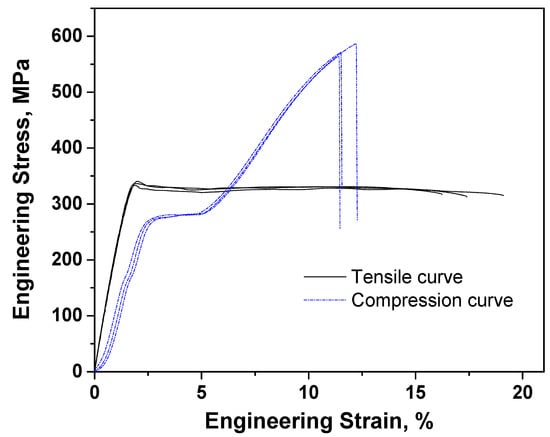
Figure 5.
The stress-strain curves of the as-extruded AXE432 alloy.
Figure 6 shows the fracture path and its related microstructure along with the fracture surface of the as-extruded AXE432 specimen failed in the tensile test. Obvious necking occurred near the fracture surface (Figure 6a), and some shear lips can be seen near the edge, which is an indication of ductile fracture. As shown in Figure 6b, many microcracks were induced by the cracking of the second-phase particles or their cluster. While very few microcracks observed away from the fracture surface (Figure 6c). Many dimples smaller than 5 μm are observed on the fracture surface (Figure 6d), indicating a ductile-oriented rupture mechanism. The formation of microcracks either at the second-phase particles or their interface with the matrix initiated the failure, and joining of the microcracks and their propagating towards the surface explains the mechanism of failure. The formation of shear lip at the fracture surface circumference suggests the final separation due to shear. Large amounts of second-phase particles are believed to have strengthened the alloy by impeding dislocation movement during the tensile test. However, the brittle particles may crush and develop into crack sources, resulting in the decrease in TYS.
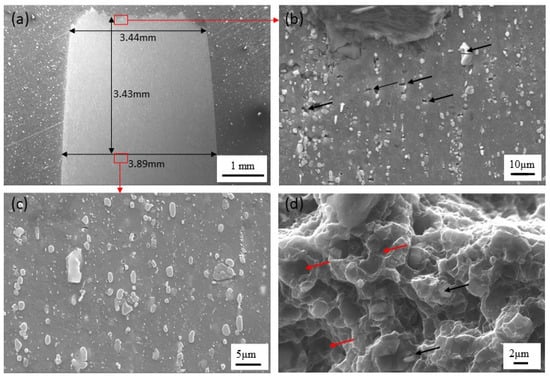
Figure 6.
(a) SEM fractographies for the vertical section of as-extruded AXE432 specimen failed in the tensile test. (b,c) The magnified images of the areas marked by red boxes in (a). (d) The fracture surface.
Table 3 shows a comparison of the reported values of the extruded experimental Mg alloys. The common feature of these alloys is their high concentration of second-phase particles, which can play a key role in refining the DRXed grain size. Some alloys, such as Mg-3.5Al-3.3Ca-0.4Mn [4], Mg-3.0Al-2.7Ca-0.4Mn [5], Mg-2.7Al-3.5Ca-0.4Mn [5], and Mg-3.5Zn-9.5Y-1.0Mn [37], showed excellent ultimate tensile strength higher than 400 MPa but poor elongation lower than 6%. Besides strength, El is another important parameter that indicates the deformability (shaping ability) of the alloy. As it is well-established, strength and ductility have opposing trends, as reported for a range of Mg-alloys such as Mg-5.99Zn-1.76Ca-0.35Mn [38], Mg-4.0Al-1.1Ca-0.4Mn, and Mg-4.0Al-2.0Ca-0.4Mn [5], all exhibited better El higher than 16% but lower strengths. Similarly, the mechanical properties of the binary alloys [33,39] are also relatively low. However, the as-extruded AXE432 alloy showed more balanced mechanical properties, with TYS and El reaching 331.4 MPa and 16.1%, respectively. Nonetheless, it is believed that there is more room for further improvement in the mechanical properties of Mg-Al-Ca-RE alloys by controlling the size, size distribution, morphology, and volume fraction of the second-phase particles in the microstructure.

Table 3.
Comparison of reported values of the extruded experimental magnesium alloys.
4. Conclusions
- (1)
- The microstructure of the as-cast AXE432 alloy consists of α-Mg, C14, and C36 phases. During the heat treatment at 480 °C for 8 h, the C14 with a fine lamellar structure changes from narrow stripes to micro-scale particles. Additionally, part of the C36 and C14 dissolve in the α-Mg matrix, and many short needle-shaped C15 (Al2Ca) phase precipitates in the primary a-Mg grains.
- (2)
- After the extrusion process at a temperature as high as 420 °C, the AXE432 alloy exhibits a refined DRXed microstructure with an average grain size less than 1.5 ± 0.5 μm because of the PSN effect and pining effect of the large number of second-phase particles.
- (3)
- A complex combination of the effects from grain size, texture, second-phase particles, and strain hardening resulted in the balanced mechanical property of the extruded AXE432 alloy, with the TYS, UTS, El, CYS, and UCS measuring 331.4 ±2.1 MPa, 336.9 ± 3.8 Mpa, 16.1 ± 2.3%, 270.4 ±1.6 Mpa, and 574.5 ± 12.4 MPa, respectively. The tensile fracture morphology is characterized by ductile-oriented rupture.
Author Contributions
Conceptualization, D.Z. and X.W.; methodology, J.Z. and D.Z.; writing—original draft preparation, J.Z., D.Z. and S.T.; funding acquisition, J.Z., Y.L. (Yunteng Liu), S.Z. and H.L.; validation, Y.L. (Yunteng Liu) and H.L.; writing—review and editing, J.Z., Y.L. (Yu Liu) and J.W.; data collection and analysis, S.Z., X.S., X.Z. and P.Y. All authors have read and agreed to the published version of the manuscript.
Funding
This research was funded by the Key R&D Program of Shandong Province, China (No. 2019GHZ019, 2021SFGC1001), the Natural Science Foundation of Shandong Province, China (No. ZR2022ME178), Major innovation project for integrating science, education & industry of Qilu University of Technology (Shandong Academy of Sciences) (No. 2022JBZ01-07), Several Policies on Promoting Collaborative Innovation and Industrialization of Achievements in Universities and Research Institutes (No. 2021GXRC126), and the Youth Innovation and Technology Support Program of Shandong Provincial Colleges and Universities (No. 2020KJA002).
Data Availability Statement
All data are available from the corresponding author on reasonable request.
Conflicts of Interest
The authors declare no conflict of interest.
References
- Liu, B.; Yang, J.; Zhang, X.; Yang, Q.; Zhang, J.; Li, X. Development and application of magnesium alloy parts for automotive OEMs: A review. J. Magnes. Alloys 2023, 11, 15–47. [Google Scholar] [CrossRef]
- Li, Y.Q.; Li, F.; Kang, F.W.; Du, H.Q.; Chen, Z.Y. Recent research and advances in extrusion forming of magnesium alloys: A review. J. Alloys Compd. 2023, 953, 170080. [Google Scholar] [CrossRef]
- Zeng, Z.; Stanford, N.; Davies, C.; Nie, J.; Birbilis, N. Magnesium extrusion alloys: A review of developments and prospects. Int. Mater. Rev. 2019, 64, 27–62. [Google Scholar] [CrossRef]
- Xu, S.W.; Oh-ishi, K.; Kamado, S.; Uchida, F.; Homma, T.; Hono, K. High-strength extruded Mg–Al–Ca–Mn alloy. Scr. Mater. 2011, 65, 269–272. [Google Scholar] [CrossRef]
- Li, Z.T.; Zhang, X.D.; Zheng, M.Y.; Qiao, X.G.; Wu, K.; Xu, C.; Kamado, S. Effect of Ca/Al ratio on microstructure and mechanical properties of Mg-Al-Ca-Mn alloys. Mater. Sci. Eng. A 2017, 682, 423–432. [Google Scholar] [CrossRef]
- Zhang, J.; Peng, P.; Yang, Q.; Luo, A.A. Bimodal grain structure formation and strengthening mechanisms in Mg–Mn–Al–Ca extrusion alloys. J. Magnes. Alloys 2023, in press. [CrossRef]
- Chai, S.; Zhong, S.; Yang, Q.; Yu, D.; Dai, Q.; Zhang, H.; Yin, L.; Wang, G.; Yao, Z. Transformation of Laves phases and its effect on the mechanical properties of TIG welded Mg-Al-Ca-Mn alloys. J. Mater. Sci. Technol. 2022, 120, 108–117. [Google Scholar] [CrossRef]
- Li, J.; Zhou, X.; Su, J.; Breitbach, B.; Chwałek, M.L.; Wang, H.; Dehm, G. Elucidating dynamic precipitation and yield strength of rolled Mg–Al–Ca–Mn alloy. Mater. Sci. Eng. A 2022, 856, 143898. [Google Scholar] [CrossRef]
- Yuan, X.; Liu, M.; Wei, K.; Li, F.; Li, X.; Zeng, X. Defect, microstructure and mechanical properties of Mg-Gd binary alloy additively manufactured by selective laser melting. Mater. Sci. Eng. A 2022, 850, 143572. [Google Scholar] [CrossRef]
- Song, J.; Chen, J.; Xiong, X.; Peng, X.; Chen, D.; Pan, F. Research advances of magnesium and magnesium alloys worldwide in 2021. J. Magnes. Alloys 2022, 10, 863–898. [Google Scholar] [CrossRef]
- Zhang, J.; Liu, S.; Wu, R.; Hou, L.; Zhang, M. Recent developments in high-strength Mg-RE-based alloys: Focusing on Mg-Gd and Mg-Y systems. J. Magnes. Alloys 2018, 6, 277–291. [Google Scholar] [CrossRef]
- Liu, C.; Chen, X.; Tolnai, D.; Hu, Y.; Zhang, W.; Zhang, Y.; Pan, F. Annealing hardening effect aroused by solute segregation in gradient ultrafine-grained Mg-Gd-Zr alloy. J. Mater. Sci. Technol. 2023, 144, 70–80. [Google Scholar] [CrossRef]
- Yu, Z.; Xu, C.; Meng, J.; Kamado, S. Microstructure evolution and mechanical properties of a high strength Mg–11.7Gd–4.9Y–0.3Zr (wt%) alloy prepared by pre-deformation annealing, hot extrusion and ageing. Mater. Sci. Eng. A 2017, 703, 348–358. [Google Scholar] [CrossRef]
- Liu, L.; Dong, B.-B.; Cheng, M.; Xue, Y.; Zhang, Z.-M. Investigation of the optimum preheating treatment parameters for extruded Mg–Gd–Y–Zn–Zr alloy using high-throughput experiments. J. Mater. Res. Technol. 2023, 25, 4050–4062. [Google Scholar] [CrossRef]
- Xia, X.; Shu, D.; Yang, E.; Hu, C. A comparative study of the role of Zn in microstructures and the mechanical properties of Mg–Gd–Y–Zr alloys. J. Mater. Res. Technol. 2023, 25, 2903–2912. [Google Scholar] [CrossRef]
- Wu, Z.; Ahmad, R.; Yin, B.; Sandlöbes, S.; Curtin, W.A. Mechanistic origin and prediction of enhanced ductility in magnesium alloys. Science 2018, 359, 447–452. [Google Scholar] [CrossRef]
- Ninomiya, R.; Ojiro, T.; Kubota, K. Improved heat resistance of Mg-Al alloys by the Ca addition. Acta Metall. Mater. 1995, 43, 669–674. [Google Scholar] [CrossRef]
- Luo, A.A.; Powell, B.R.; Balogh, M.P. Creep and microstructure of magnesium-aluminum-calcium based alloys. Metall. Mater. Trans. A 2002, 33, 567–574. [Google Scholar] [CrossRef]
- Suzuki, A.; Saddock, N.; Jones, J.; Pollock, T. Structure and transition of eutectic (Mg,Al)Ca Laves phase in a die-cast Mg–Al–Ca base alloy. Scripta Mater. 2004, 51, 1005–1010. [Google Scholar] [CrossRef]
- Suzuki, A.; Saddock, N.D.; Jones, J.W.; Pollock, T.M. Solidification paths and eutectic intermetallic phases in Mg–Al–Ca ternary alloys. Acta Mater. 2005, 53, 2823–2834. [Google Scholar] [CrossRef]
- Liang, S.M.; Chen, R.S.; Blandin, J.J.; Suery, M.; Han, E.H. Thermal analysis and solidification pathways of Mg–Al–Ca system alloys. Mater. Sci. Eng. A 2008, 480, 365–372. [Google Scholar] [CrossRef]
- Watanabe, H.; Yamaguchi, M.; Takigawa, Y.; Higashi, K. Mechanical properties of Mg–Al–Ca alloy processed by hot extrusion. Mater. Sci. Eng. A 2007, 454–455, 384–388. [Google Scholar] [CrossRef]
- Rzychoń, T. Characterization of Mg-rich clusters in the C36 phase of the Mg–5Al–3Ca–0.7Sr–0.2Mn alloy. J. Alloys Compd. 2014, 598, 95–105. [Google Scholar] [CrossRef]
- Janz, A.; Grobner, J.; Cao, H.; Zhu, J.; Chang, Y.; Schmidfetzer, R. Thermodynamic modeling of the Mg–Al–Ca system. Acta Mater. 2009, 57, 682–694. [Google Scholar] [CrossRef]
- Robson, J.D.; Henry, D.T.; Davis, B. Particle effects on recrystallization in magnesium-manganese alloys: Particle-stimulated nucleation. Acta Mater. 2009, 57, 2739–2747. [Google Scholar] [CrossRef]
- Robson, J.D.; Henry, D.T.; Davis, B. Particle effects on recrystallization in magnesium-manganese alloys: Particle pinning. Mater. Sci. Eng. A 2011, 528, 4239–4247. [Google Scholar] [CrossRef]
- Zareian, Z.; Emamy, M.; Malekan, M.; Mirzadeh, H.; Kim, W.J.; Bahmani, A. Tailoring the mechanical properties of Mg–Zn magnesium alloy by calcium addition and hot extrusion process. Mater. Sci. Eng. A 2020, 774, 138929. [Google Scholar] [CrossRef]
- Pan, H.C.; Yang, C.L.; Yang, Y.T.; Dai, Y.Q.; Zhou, D.S.; Chai, L.J.; Huang, Q.Y.; Yang, Q.S.; Liu, S.M.; Ren, Y.P.; et al. Ultra-fine grain size and exceptionally high strength in dilute Mg–Ca alloys achieved by conventional one-step extrusion. Mater. Lett. 2019, 237, 65–68. [Google Scholar] [CrossRef]
- Zhang, A.; Kang, R.; Wu, L.; Pan, H.; Xie, H.; Huang, Q.; Liu, Y.; Ai, Z.; Ma, L.; Ren, Y.; et al. A new rare-earth-free Mg–Sn–Ca–Mn wrought alloy with ultra-high strength and good ductility. Mater. Sci. Eng. A 2019, 754, 269–274. [Google Scholar] [CrossRef]
- She, J.; Pan, F.S.; Guo, W.; Tang, A.T.; Gao, Z.Y.; Luo, S.Q.; Song, K.; Yu, Z.W.; Rashad, M. Effect of high Mn content on development of ultra-fine grain extruded magnesium alloy. Mater. Des. 2016, 90, 7–12. [Google Scholar] [CrossRef]
- Jiang, M.G.; Xu, C.; Nakata, T.; Yan, H.; Chen, R.S.; Kamado, S. Development of dilute Mg–Zn–Ca–Mn alloy with high performance via extrusion. J. Alloys Compd. 2016, 668, 13–21. [Google Scholar] [CrossRef]
- Zhang, B.P.; Geng, L.; Huang, L.J.; Zhang, X.X.; Dong, C.C. Enhanced mechanical properties in fine-grained Mg–1.0Zn–0.5Ca alloys prepared by extrusion at different temperatures. Scr. Mater. 2010, 63, 1024–1027. [Google Scholar] [CrossRef]
- Singh, A.; Osawa, Y.; Somekawa, H.; Mukai, T. Ultra-fine grain size and isotropic very high strength by direct extrusion of chill-cast Mg–Zn–Y alloys containing quasicrystal phase. Scr. Mater. 2011, 64, 661–664. [Google Scholar] [CrossRef]
- Zhao, D.; Li, G.; Li, P.; Zhou, J.; Cheng, K.; Liu, Y.; Yang, Y.; Duan, J.; Ghomashchi, R.; Wang, X. A comparative study on the microstructures and mechanical properties of the Mg–xCa/Mn/Ce alloys and pure Mg. Mater. Sci. Eng. A 2021, 803, 140508. [Google Scholar] [CrossRef]
- Wu, J.; Jin, L.; Dong, J.; Wang, F.; Dong, S. The texture and its optimization in magnesium alloy. J. Mater. Sci. Technol. 2020, 42, 175–189. [Google Scholar] [CrossRef]
- Bohlen, J.; Yi, S.; Letzig, D.; Kainer, K.U. Effect of rare earth elements on the microstructure and texture development in magnesium–manganese alloys during extrusion. Mater. Sci. Eng. A 2010, 527, 7092–7098. [Google Scholar] [CrossRef]
- Qi, F.; Zhang, D.; Zhang, X.; Xu, X. Effects of Mn addition and X-phase on the microstructure and mechanical properties of high-strength Mg-Zn-Y-Mn alloys. Mater. Sci. Eng. A 2014, 593, 70–78. [Google Scholar] [CrossRef]
- Xu, S.W.; Oh-ishi, K.; Sunohara, H.; Kamado, S. Extruded Mg–Zn–Ca–Mn alloys with low yield anisotropy. Mater. Sci. Eng. A 2012, 558, 356–365. [Google Scholar] [CrossRef]
- Pan, H.; Qin, G.; Ren, Y.; Wang, L.; Sun, S.; Meng, X. Achieving high strength in indirectly-extruded binary Mg–Ca alloy containing Guinier-Preston zones. J. Alloys Compd. 2015, 630, 272–276. [Google Scholar] [CrossRef]
Disclaimer/Publisher’s Note: The statements, opinions and data contained in all publications are solely those of the individual author(s) and contributor(s) and not of MDPI and/or the editor(s). MDPI and/or the editor(s) disclaim responsibility for any injury to people or property resulting from any ideas, methods, instructions or products referred to in the content. |
© 2023 by the authors. Licensee MDPI, Basel, Switzerland. This article is an open access article distributed under the terms and conditions of the Creative Commons Attribution (CC BY) license (https://creativecommons.org/licenses/by/4.0/).